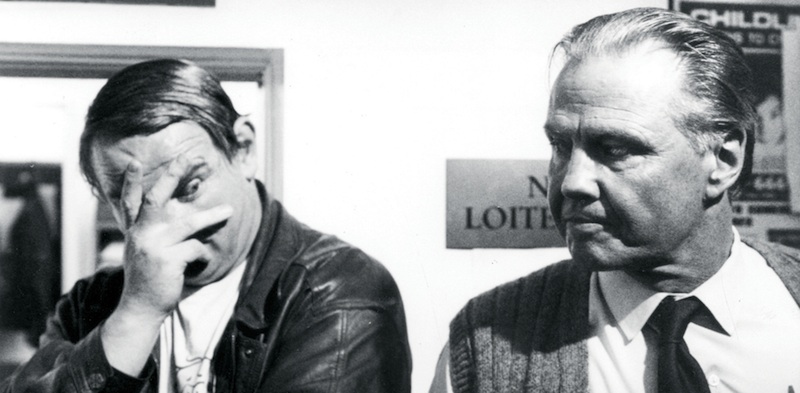“The Truman Show” (1998): A Prescient Meditation on Reality and Surveillance – Film Review

Released in 1998, “The Truman Show,” directed by Peter Weir, is a profoundly intriguing film that blends elements of comedy, drama, and science fiction to explore themes of personal freedom, voyeurism, and the ethics of media consumption. Starring Jim Carrey in a role that marked a significant departure from his typical slapstick comedy roles, the film not only challenged Carrey’s acting range but also presaged the reality television boom and the contemporary concerns regarding privacy and surveillance in the digital age.
Jim Carrey’s Pivotal Role Transition
Jim Carrey, known for his exuberant and elastic facial expressions in broad comedies like “Ace Ventura” and “Dumb and Dumber,” took on “The Truman Show” as a means to pivot towards more serious, dramatic roles. His portrayal of Truman Burbank, an everyman unknowingly living in a fabricated reality TV show, was both nuanced and restrained, displaying his capacity for depth and sensitivity without losing his innate charm. This performance earned Carrey critical acclaim, showing that his talents extended far beyond comedic antics and positioned him as a versatile actor capable of handling complex roles.
The Truman Show Delusion and Psychological Impact
“The Truman Show” delves into the psychological impact of living a life under constant observation, a theme that resonates deeply in today’s digital and media-saturated culture. The film’s exploration of Truman’s gradual unraveling as he discovers the truth about his world has been so impactful that it inspired the term “The Truman Show delusion,” used in psychology to describe patients who believe their lives are staged reality shows or that they are being watched on cameras. The condition underscores the movie’s powerful commentary on the blurring lines between reality and entertainment, a topic that has only become more pertinent with the rise of social media and reality TV.
Exploring Thematic Depth and Character Development
“The Truman Show” masterfully explores the psychological and ethical dimensions of Truman Burbank’s life, a character unwittingly trapped in a television show that has broadcast every moment of his existence since birth. As Truman slowly discovers the nature of his world, his journey from naive contentment to desperate escape attempts illustrates a profound narrative about human resilience and the quest for truth.
Jim Carrey’s portrayal of Truman evolves throughout the film—from the cheerful, if somewhat naive, insurance salesman to a man tormented by the discovery of his life’s artifice. This transformation is central to the film’s emotional impact. Carrey’s performance skillfully balances the comedic elements of his earlier career with the dramatic demands of the role, creating a character that is relatable and deeply human in his existential struggle.
Technical Brilliance and Artistic Choices
Peter Weir’s directorial choices amplify the film’s thematic concerns. The extensive use of fixed camera angles and shots that mimic surveillance footage serve as a constant reminder of Truman’s lack of privacy, cleverly implicating the film’s audience as part of the voyeuristic masses who watch Truman’s life unfold as entertainment. This meta-narrative technique not only deepens the film’s commentary on surveillance but also challenges viewers to consider their complicity in consuming real-life dramas as entertainment.
The film’s production design, led by Dennis Gassner, meticulously crafted Seahaven to represent an idyllic 1950s American suburb, a setting that is both comforting and eerily perfect. The choice of setting serves as a critique of nostalgia and the often sanitized versions of reality that media chooses to present. The artificiality of Seahaven is highlighted by the omnipresent pleasant weather and the town’s overly friendly inhabitants, further underscoring the constructed nature of Truman’s world.
Psychological Impact and Broader Implications
The introduction of “The Truman Show delusion” in psychological discourse underscores the film’s profound impact on public and academic thought. Psychologists have discussed the movie in the context of paranoia and the increasingly blurred line between reality and mediated experiences. The condition reflects growing concerns about privacy in an age where surveillance and data collection are pervasive and often invisible.
The film’s exploration of these themes predates many of the privacy dilemmas brought about by the digital age, making it a prescient piece of cinema that has grown only more relevant with time. Discussions about personal autonomy, privacy rights, and the ethical considerations of reality television continue to draw on examples from the film.
Cinematic Techniques and Storytelling
Director Peter Weir used a variety of cinematic techniques to emphasize the artificiality of Truman’s world. The film employs unusual camera angles and shots that mimic CCTV to reinforce the idea that Truman’s life is continuously being filmed and broadcast to an oblivious global audience. The use of bright, saturated colors in the set design of Seahaven (Truman’s hometown) also contributes to the uncanny, idyllic quality of the environment, subtly hinting at the artificial nature of the world Truman inhabits.
Behind the Scenes: Production and Direction
The production of “The Truman Show” was groundbreaking for its time, requiring extensive set construction to create the dome-covered town of Seahaven. The set was designed to be fully functional, allowing for the seamless movement of actors and cameras, mimicking the operations of a real television show. This immense undertaking was crucial in maintaining the illusion of a continuous broadcast, a key element of the film’s premise.
Peter Weir’s direction is particularly noteworthy for its balance of satire and sincerity. He manages to evoke empathy for Truman, making audiences question the ethical implications of their own media consumption habits. Weir’s thoughtful approach helps the film navigate its profound themes without becoming overly didactic.
Legacy and Continued Relevance
“The Truman Show” received critical acclaim upon its release, particularly for Jim Carrey’s performance and the film’s innovative storytelling. It was nominated for several major awards, highlighting its technical achievements and compelling narrative. The film’s continued relevance is evident in its frequent inclusion in discussions about media ethics, privacy, and the psychological effects of reality television.
Its legacy is also evident in its influence on other media, inspiring episodes of television shows, novels, and theatrical productions that explore similar themes of surveillance, media saturation, and the search for authenticity in a manufactured world.
As “The Truman Show” continues to be a reference point in cultural discussions about the impact of media on individual identity and societal values, its place in cinematic history is marked not only by its storytelling prowess but also by its foresight into issues that have become central to contemporary life. Further analysis of this film reveals how deeply interwoven its themes are with the fabric of modern societal concerns, emphasizing its role as a critical lens through which to view our evolving relationship with media and technology.




